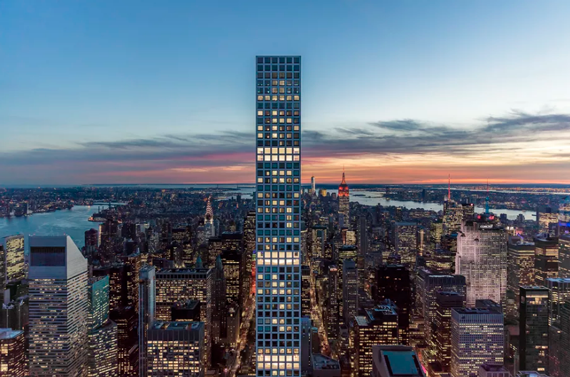The meaning of the three letters in CIM Group’s name is one of real estate’s best-kept secrets. But it might as well stand for Condos In Manhattan.
Towering over Midtown at 432 Park Avenue is the tallest apartment building in the Western hemisphere. On the Upper East Side stands a condo conversion at 737 Park Avenue. Further east at 305 East 51st Street, the Halcyon rises over Turtle Bay. Bookending Madison Square Park is the slender One Madison. And further south, across from the World Trade Center, is 100 Barclay Street. All these projects are either backed or co-developed by CIM.
It’s rare for a firm to have a hand in that many Manhattan condo projects. For private fund managers that invest billions on behalf of pension funds, insurance firms and endowments, it’s unheard of. CIM’s peers like the Blackstone Group and Beacon Capital Partners tend to buy trophy properties or entire portfolios and flip them a few years later for a profit — a practice that requires plenty of capital, patience and financial engineering, but little actual hard-hat work. CIM, though, seems to relish the risk of construction.
“They have a developer’s DNA, and work very well through complicated situations,” said Jared Kushner [TRDataCustom], whose Kushner Companies has partnered with CIM on office deals, including the Watchtower building in Brooklyn. “They understand the bricks and make quick decisions.”
For CIM, backing condo developers has paid off handsomely. But it also carries great risk. And a recent slowdown in the high-end market begs the question: can the firm’s run in New York continue?
The Ground-Up Game
CIM only got into the New York real estate game in 2009. Financial markets were reeling from the crash, and the Los Angeles-based firm sensed an opportunity. Its principals scoped out troubled properties, going hunting for any major developer who was in trouble, according to one broker familiar with the firm who spoke on condition of anonymity. They found plenty.
Harry Macklowe had bought the historic Drake Hotel for $440 million in 2006 and razed it with plans to build a luxury condo tower on the site. But after he defaulted on a loan during the crisis, his lender, Deutsche Bank, came calling. Reluctant to surrender the site, Macklowe found a messiah in CIM, which bought $510 million in defaulted debt at a discount in late 2009 and took over an equity stake in the project, becoming co-developer.
Savills Studley’s Woody Heller, who brokered the 432 Park deal for CIM, said the firm was initially looking to buy three rental properties from Macklowe. But it took a gamble on the developer.
“In late 2009 and early 2010 when the world felt like it was coming to an end, they were prepared to put up a lot of money all cash, north of $300 million, to buy a vacant development site,” Heller said. “This was at a time when there was not only no land acquisition financing but no construction financing, so it wasn’t clear how they would be able to finance the construction of the building.”
On the land deal alone, CIM hit the cap on how much of its investors’ money it could invest in a single project, according to Heller, which meant that it needed to find outside construction financing in a hostile lending environment to develop the project. They found it at an unusual (at the time) source, borrowing $400 million from Children’s Investment Fund, a U.K.-based hedge fund.
The partners built a 1,396-foot-tall luxury condo tower for about $1.3 billion. The tower’s latest projected sellout, according to filings with the New York Attorney General, is $3.13 billion. Sales prices on some of the pads have surpassed $9,000 a foot, though many are now trading for significant discounts to their asking price.
[vision_pullquote style=”3″ align=”right”] “They were prepared to put up a lot of money all cash, north of $300 million, to buy a vacant development site.” — Woody Heller [/vision_pullquote] Macklowe and CIM went on to partner on 737 Park Avenue, which they converted into luxury condos. Average sales prices at the property have exceeded $3,000 per foot in the last three years, CityRealty data show.
“It’s actually the best partnership I have ever had,” Macklowe gushed to TRD. CIM’s principals have been deeply involved in 432 Park, he said, “without being in any way aggressive or unpleasant.”
“They were enormously confident in the decisions I was making for 432 Park Ave which were multimillion-dollar decisions,” Macklowe added. “It’s remarkable that I’ve had a relationship with them for six or seven years and we’ve never had a disagreement.”
CIM’s co-founder Avi Shemesh saw it a little differently in a 2011 interview with the Wall Street Journal, when he made it clear who was in charge. Macklowe, Shemesh said, is “involved with the thought process and decision-making, but the final decision is ours.”
Investors who’ve worked with CIM point to their development savvy. Nir Meir, a managing principal at HFZ Capital Group, recalled looking for someone in 2012 to bankroll the construction of the Halcyon, HFZ’s 32-story condo tower.
HFZ was courting other investors, but CIM’s principals showed a deeper understanding of the nuts and bolts of high-rise development, according to Meir.
“The chemistry we had with them was just very pleasant,” he said.
And unlike some unwieldy institutions, CIM was able to move quickly: Not long after their first talk, it pledged an $85 million equity investment, according to Real Capital Analytics. HFZ and CIM then joined forces with Related Companies to complete One Madison, a stalled condo project that they acquired out of bankruptcy in April 2012. In 2014, Rupert Murdoch bought two units there for a combined $57.3 million.
For CIM, ground-up development offers a rare chance to one-up rival fund managers. Competition in the private real estate fund business is fierce, and CIM can’t compete with the sheer financial heft of Blackstone when it comes to bidding for multibillion-dollar portfolios. But other fund managers, who tend to come to real estate from the world of finance, have been reluctant to get involved in construction as equity partners.
“Ground-up construction comes with its pitfalls, cost overruns, time overruns and worries about the market – especially today where it’s tougher to get financing,” said Howard Lorber, chair of brokerage Douglas Elliman and an active new development investor through his firm, New Valley. This has created a profitable opening for CIM, which has two founders, Shaul Kuba and Shemesh, with real estate pedigree.
“If you need to return high teens or 20 percent IRR, you have to go that [development] route,” the broker familiar with CIM said.
From shrubs to skyscrapers
Kuba and Shemesh, who both served as paratroopers in the Israeli army, immigrated to Los Angeles in the 1980s and began investing in Santa Monica properties while also running a landscaping business. According to a 2011 TRD profile of the firm, they met Richard Ressler, a former attorney and investment banker, in 1987 when they visited his home for a landscaping consultation. In 1994, the three men launched CIM and began buying and repositioning properties in greater Los Angeles and San Diego.
[vision_pullquote style=”3″ align=”right”] “It’s actually the best partnership I have ever had.” –Harry Macklowe [/vision_pullquote]The principals are still based on the West Coast, although CIM now has a New York office. Their corporate website reads like something out of “Office Space” – lots of references to “integrity,” “ethics,” and a “flat organizational structure.”
Lorber, who worked with Ressler in the 1980s at Brooke Overseas Limited and has remained in contact since, said when it comes to potential acquisitions, CIM’s principals will “sort of look at anything.”
A source said Kuba and Shemesh take care of the firm’s development projects, while Ressler oversees the firm’s investments and asset management divisions through a company called Orchard Capital.
Kuba and Shemesh “go out there and call owners and brokers” over potential deals, said one broker. “They are hustlers.”
But in at least one instance involving the California public pension fund CalPERS, that hustling got them into some drama.
An internal 2011 CalPERS review found that CIM used a placement agent to market an investment to the pension fund in 2000. In 2005 and 2006, CIM invited CalPERS board members to the Oscars held at the Kodak Theater, owned by a CIM-managed fund in which CalPERS had invested. A placement agent who had been paid by CIM until 2000 paid for their hotel and dinner. The report found no wrongdoing on CIM’s behalf and CalPERS agreed to continue the partnership with the fund manager. While the investigation was ongoing, CIM agreed to waive $50 million in fees over several years as a condition for being named as CalPERS’ “strategic investment manager.”
CIM’s embrace of development can lead to friction with tenants, and to bad press. In September, the Los Angeles Times ran a feature alleging CIM bought unsuspecting renters out of their rent-controlled units by offering them far less money than they were legally entitled to. And in Manhattan, at 737 Park, where CIM is a limited partner and lender, rent-controlled tenants refusing to leave the building significantly delayed construction.
Investing in distressed developments can also create friction with other developers. “They have a reputation that is preceding them in that they are partners and lenders of last resort,” said Edward Mermelstein, an attorney who sued CIM on behalf of his client NMP Group in 2011. NMP, which was in trouble over a development at 33rd Street and Madison Avenue at the time, claimed it had a verbal agreement with CIM to partner on the deal, only to see CIM buy the $29 million mortgage and move to foreclose instead. “If they were of any other reputation other than the one they have they would have indicated right from the beginning that their interest is in buying the loan,” Mermelstein said. The suit was subsequently dismissed. In 2013, NMP filed for bankruptcy over the site at 172-176 Madison Avenue, blocking the foreclosure. Later that year, Yitzchak Tessler jumped in to develop the project with NMP.
And finally, ground-up development carries a risk unique to closed-end fund managers like CIM. These funds often have a fixed term (usually 10 years) after which the money needs to be returned to investors. A decade may be plenty of time, but what if a construction project gets delayed? The uncertainty of how long a project can take may help explain why other private equity firms have not made as big bets on ground-up projects as CIM.
“It can be tough to get the timing right,” one executive at a rival fund manager said.
Tall profits
Some firms like CIM think ground-up development is worth the trouble because of its potential for fat profits. As a private company, CIM doesn’t disclose how much money it made on its early condo projects. but public records offer a hint. At the time of writing, 98 percent of One Madison’s 91 apartments were sold, with a combined sales price of $454.8 million, according to CityRealty. At Halcyon, 91 percent of units were sold for a combined $311.1 million. At 737 Park, which Macklowe and CIM bought for $253 million, the sellout to-date is $462.3 million, or 77 percent of its units. These numbers don’t include in-contract deals.
At 432 Park, 79 units have sold for a combined price of $1.52 billion, according to Streeteasy. CIM and Macklowe declined to comment on the status of sales at the building.
Sales at the building have always been a mystery. In November 2013, a New York Times article claimed without attribution that “about 50 percent of the building is in contract” after less than a year of marketing. By September 2014, anonymous sources close to the project told Forbes that 70 percent were now sold. In November 2015, a spokesperson told TRD that 70 percent of units were in contract.
The building’s priciest penthouse sold in September for $88 million. But property records show that CIM helped the buyer – reported to be Saudi billionaire Fawaz Al Hokair – with a $56 million purchase money mortgage. In other words: it looks to have only received a small portion of the sales price at closing.
CIM declined to comment on why it issued the mortgage. A condo attorney said such an arrangement is “very unorthodox” for such a pricey apartment. There could be several reasons for a purchase money mortgage, he speculated. For one, a foreign buyer may not be able to get the full purchase sum into the U.S. by the time of the closing.
Apart from its condo developments, the firm has also done more straightforward acquisitions. In mid-2013, it bought two Downtown office buildings, paying $140 million for 2 Rector Street in partnership with Kushner Companies and $104 million for 5 Hanover Square. Kushner and CIM sold 2 Rector Street for $225 million this March . In 2013, CIM partnered with L+M Development Partners and Citigroup to buy the housing complex Lands End II at 265-275 Cherry Street for $279.2 million.
CIM’s most opportunistic – and likely most profitable – New York deal was its 2010 agreement to assume the Sapir Organization’s debt in return for stakes in its properties like Trump Soho and the William Beaver House. CIM also took over a 49-percent stake in Sapir’s office building 11 Madison Avenue for $469 million, valuing the tower at $957.5 million, according to Real Capital Analytics. Sources close to Sapir said the partners were able to triple the building’s net operating income.
Last June, Sapir and CIM sold the building to SL Green for $2.3 billion. CIM’s equity investment in 11 Madison was about $85 million, according to the Wall Street Journal, giving it a profit of over $600 million on the deal.
Branching out
The 11 Madison sale may have been CIM’s greatest financial triumph, but it also highlights the dilemma it now faces. The company made a fortune buying distressed real estate at bargain prices and selling it as the market recovered. But now that prices have ballooned, it’s much tougher for the company to put its investors’ money to work.
“Stable assets are trading for very, very high values; everyone is looking at stable assets in the best markets and they want to achieve the best returns,” Shemesh told trade publication Pensions & Investments in 2013. “They want stable assets with some upside. The issue is, how can you achieve that? You have to do more than review brokers’ packages.”
If condo projects were CIM’s bread and butter post-2008, they play a far smaller role now. Aside from 432 Park, the firm is currently doing only one Manhattan condo project: it is partnering with Ben Shaoul’s Magnum Real Estate Group at 100 Barclay, the $915 million conversion of the former Verizon building at 140 West Street into a 161-unit condo building. Unlike its earlier condo deals, CIM didn’t get the property at a recession discount. For the investment to pay off, it will likely have to hope that the recent slowdown in condo sales is merely temporary.
One real estate executive, who is not involved in the project and spoke on condition of anonymity, said a challenge for 100 Barclay is that the conversion features a lot of large, pricey apartments. Brokers have long noted that demand for such units has slowed across Manhattan. Of the 63 apartments at 100 Barclay currently named as active listings on Streeteasy, 61 have three or more bedrooms.
“What they should have done is a lot more one- and two-bedrooms, and they could have positioned them next to three or four-bedrooms” for possible combinations, the executive said. “They would not have been as susceptible to a drop-off in demand on the high end.” Still the executive believes the project will be a success, if the developers can wait a year or two for high-end sales prices to recover. In April, Shaoul opted to bring in Corcoran Sunshine to handle sales at the project, replacing Elliman. He declined to provide sales figures at the time.
As condos become more difficult to pencil out, CIM has branched out into different markets and product types. The firm bought 17 Manhattan properties between January 2010 and December 2013, according to RCA. But over the past two years, faced with a more competitive investment market in New York, CIM has spent heavily in other cities. The firm closed its latest $2.4 billion real estate fund in January 2015. Of the 38 properties it has bought since then, just three were in New York, according to RCA (between December 2010 and December 2012, 10 of its 21 acquisitions were in New York). In September, the firm went into contract to buy the Tribune Tower in Chicago for $240 million.
In recent months, the firm has become more active in New York again. In November 2015, it bought the Martha Washington Hotel at 29 East 29th Street for $157.7 million. And in August, CIM, Kushner Companies and LIVWRK closed on the $340 million acquisition of the Watchtower office building in Dumbo.

The Watchtower building in Dumbo
“While they have looked for a deal in Brooklyn for a while, it is always hard to find the right scale in Brooklyn, a market in which the majority of the transactions are too small for institutional equity funds,” said Ofer Cohen, who heads the Brooklyn brokerage TerraCRG.
[vision_pullquote style=”3″ align=”right”] “You have to do more than review brokers’ packages.” –Avi Shemesh [/vision_pullquote] Cohen described the Watchtower acquisition as “unique and lucrative” because of its scale. But it’s also a risky one. The old building requires a costly redevelopment, and no one can say for certain what the Brooklyn office market will look like when it’s ready for leasing. Nearly 10 million square feet of new office space is scheduled to hit Brooklyn by the end of 2020, according to Bloomberg. Meanwhile, demand from the type of tech tenants that tend to be drawn to Brooklyn shows signs of weakening. Venture funding for New York firms dropped by 40 percent between the second quarter of 2015 and the second quarter of 2016, according to Bloomberg, while the office availability rate in Brooklyn rose to 14.5 percent from 13.1 percent.
In August, Kushner, LIVWRK and CIM landed a $374 million financing package from Blackstone and SL Green for the project. A source familiar with the project said that the substantial sum CIM contributed in equity was a “big difference maker” in landing the financing.
“There are a lot of projects out there that want to move forward that can’t get as much construction financing as they thought they were going to get,” said RXR Realty’s Scott Rechler, whose firm has recently invested in construction debt. “So I think they can be a good participator in the capital stack to help fund those projects.”
In early December, CIM and L+M Development Partners unveiled plans to build two rental apartment towers on a lot immediately adjacent to their 265-275 Cherry Street property. The two towers will span more than a million square feet and include up to 1,350 apartments. Right now, the Two Bridges neighborhood surrounding the site is dominated by public housing. But with Extell Development, JDS Development Group and Starrett Corporation all planning residential towers there, it’s very much a neighborhood in transition.
The South Street rental project shows that CIM’s appetite for ground-up development hasn’t slowed even as its trademark condo deals become less appealing. And if the real estate cycle ends and more developers end up in financial trouble, CIM could once again find the kind of opportunities to invest in distressed real estate it saw in 2009 and 2010.
“We’re six years into the recovery. Recoveries don’t typically last much longer than this,” Heller said. “So they might be well poised for the next cycle, to do it all again.”



